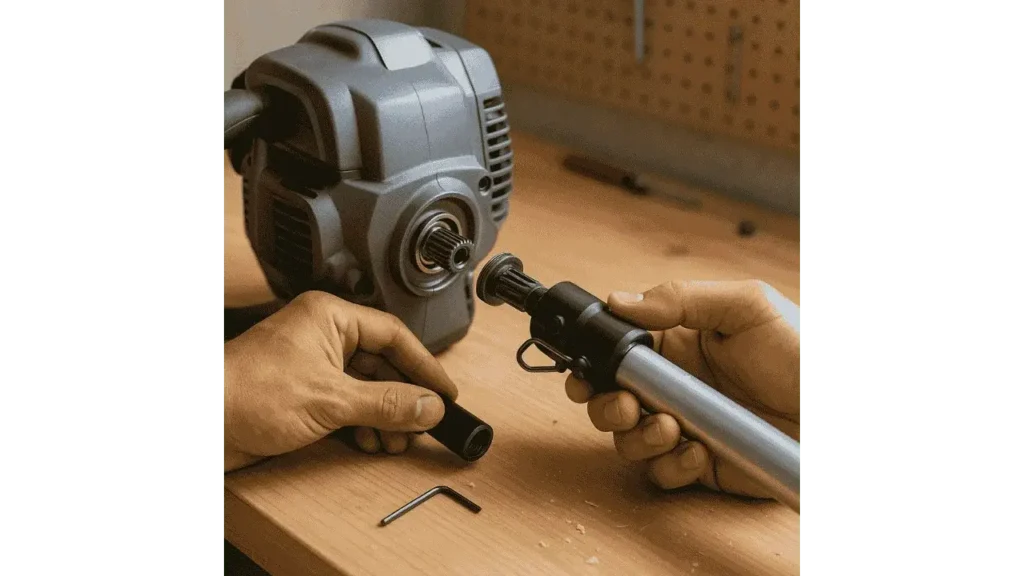A chainsaw and a pole saw may share the same cutting heart, but they serve very different roles in the yard. One is made for raw power at ground level, the other for safe trimming above your head. Yes, it’s possible to convert certain chainsaws into pole saws, but only if done with proper tools, techniques, and an eye toward safety. For homeowners looking to stretch their tools a bit further, conversion can be tempting; yet, not all setups are created equal.

Official Manufacturer Conversion Kits
Some brands make this easier than others. Sun Joe, EGO, Shop Joe, and a few others offer official conversion kits that turn their chainsaws or powerheads into pole saws. These kits typically include a telescoping pole, connectors, and a redesigned cutting head, all made to fit seamlessly.
These setups also feature secure locking mechanisms, helping ensure that the attachment stays stable and safe even when fully extended. If your model is supported, this is the smartest and safest route.
Steps for DIY Conversion Using a Kit
Disconnect Chainsaw or Powerhead
Always start by disconnecting the battery or spark plug, and refer to the user manual. Detach the existing cutting head and grip handles safely. This avoids accidental startups and prepares the chainsaw for conversion.
Attach to Telescoping Pole
Align the cutting head with the adapter socket on the pole and insert it securely until you hear or feel a lock click into place. Attach the handle section next, ensuring both ends are stable and flush against the connecting points.
Lock and Test Assembly
After assembly, engage all locking features and inspect the connections. Spin the tool gently while powered off to feel for imbalance or looseness. Only proceed if everything is securely fitted.
Alternative DIY Methods (with Caution)
Technically inclined users have been known to repurpose parts from string trimmers or other shaft-driven tools by fabricating adapters or gearbox swaps. However, these setups can pose serious risks.
Improper modifications often result in misaligned drive shafts, unsafe poles that can’t support the chainsaw’s weight, or the complete absence of essential safety mechanisms like brakes or guards.
As tool safety engineer Kirk Halloway warns:
“Unless you’re confident in both fabrication and tool dynamics, home-built conversions are more likely to hurt than help.”
Safety & Usability Considerations
One major advantage of official kits is that they preserve key safety features like handguards, kill switches, and proper grip spacing. DIY rigs rarely offer that level of refinement.
Extended tools also introduce balance and reach challenges, especially with heavy chainsaws. A poorly aligned pole can lead to kickback or slipping.
Improvised solutions may also void warranties, leaving you without support if something goes wrong.
Pros and Cons of Converting
Pros:
Converting your existing chainsaw can be more affordable than buying a separate pole saw, especially if a compatible powerhead is already in your garage. It allows tool reuse and saves space by avoiding extra purchases. Done properly, it creates a versatile multi-tool setup.
Cons:
However, balance and handling may suffer, especially when operating overhead. DIY conversions often lack proper safety mechanisms, which puts the user at greater risk. You also risk voiding manufacturer warranties, and there’s a heightened chance of mechanical failure or personal injury if done incorrectly.
When It’s Better to Buy a Dedicated Pole Saw
If you’re frequently trimming tree limbs, it’s worth investing in a purpose-built pole saw. These are designed with weight distribution, anti-vibration handles, and longer-lasting drive systems that excel overhead.
For professionals or those dealing with thick branches, a gas-powered or high-reach electric model will outperform a DIY rig every time.
As arborist Daniel Rusk puts it:
“A converted chainsaw gets the job done once. A real pole saw gets it done right every time.”
Conclusion
Yes, converting a chainsaw to a pole saw is possible; but only if your model is designed for it and you’re using the proper kit. Manufacturer-supported conversions offer the best balance of safety, performance, and ease. Avoid makeshift DIY setups unless you truly know what you’re doing and are willing to accept the risks. When in doubt, opt for a dedicated pole saw to ensure safe, consistent, and professional-grade results.
- How to Cut a Straight Line with a Jigsaw? - October 31, 2025
- How to Cut a Circle with a Jigsaw? - October 31, 2025
- Can You Cut Acrylic with a Jigsaw? - October 31, 2025
